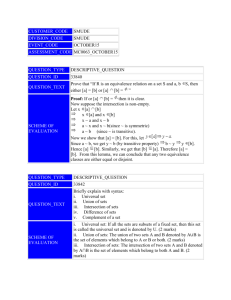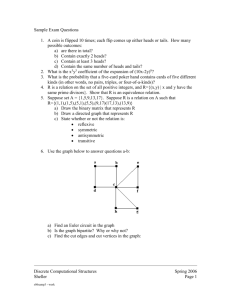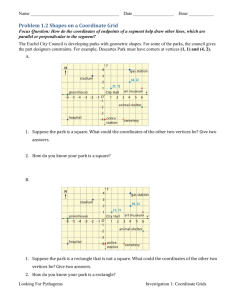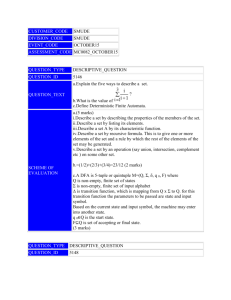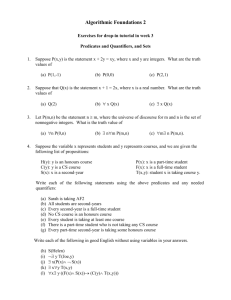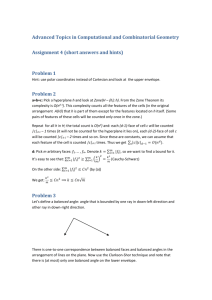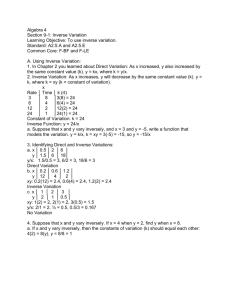CUSTOMER_CODE SMUDE DIVISION_CODE SMUDE
advertisement
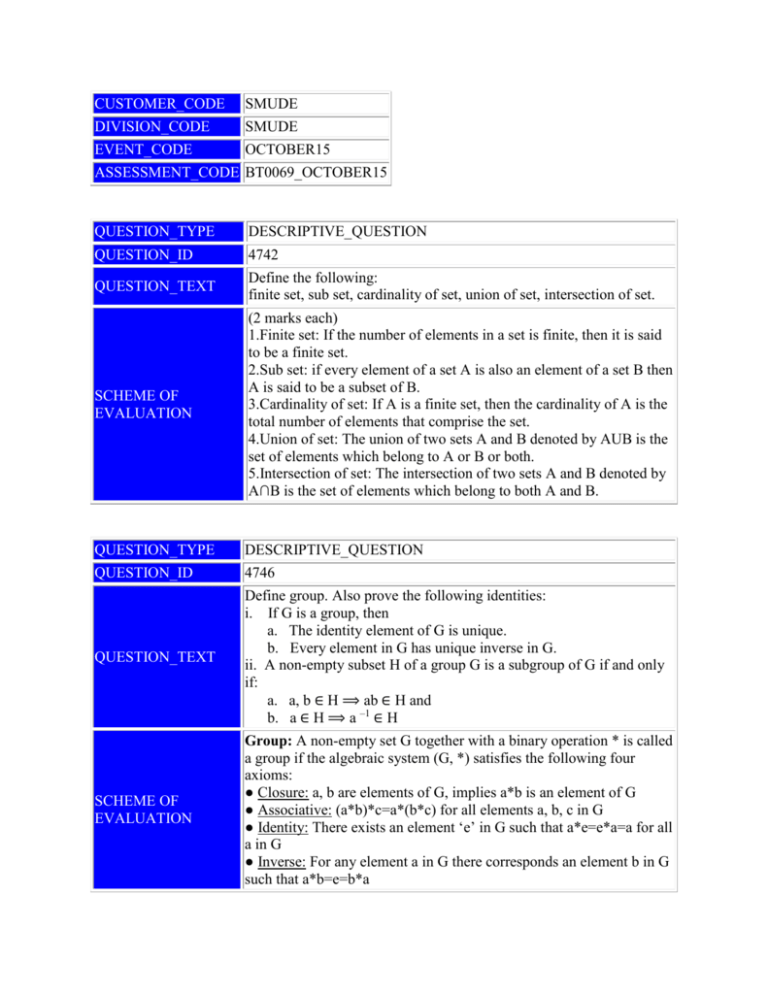
CUSTOMER_CODE
SMUDE
DIVISION_CODE
SMUDE
EVENT_CODE
OCTOBER15
ASSESSMENT_CODE BT0069_OCTOBER15
QUESTION_TYPE
DESCRIPTIVE_QUESTION
QUESTION_ID
4742
QUESTION_TEXT
Define the following:
finite set, sub set, cardinality of set, union of set, intersection of set.
SCHEME OF
EVALUATION
(2 marks each)
1.Finite set: If the number of elements in a set is finite, then it is said
to be a finite set.
2.Sub set: if every element of a set A is also an element of a set B then
A is said to be a subset of B.
3.Cardinality of set: If A is a finite set, then the cardinality of A is the
total number of elements that comprise the set.
4.Union of set: The union of two sets A and B denoted by AUB is the
set of elements which belong to A or B or both.
5.Intersection of set: The intersection of two sets A and B denoted by
A∩B is the set of elements which belong to both A and B.
QUESTION_TYPE
DESCRIPTIVE_QUESTION
QUESTION_ID
4746
QUESTION_TEXT
Define group. Also prove the following identities:
i. If G is a group, then
a. The identity element of G is unique.
b. Every element in G has unique inverse in G.
ii. A non-empty subset H of a group G is a subgroup of G if and only
if:
a. a, b ∈ H ⟹ ab ∈ H and
b. a ∈ H ⟹ a –1 ∈ H
SCHEME OF
EVALUATION
Group: A non-empty set G together with a binary operation * is called
a group if the algebraic system (G, *) satisfies the following four
axioms:
● Closure: a, b are elements of G, implies a*b is an element of G
● Associative: (a*b)*c=a*(b*c) for all elements a, b, c in G
● Identity: There exists an element ‘e’ in G such that a*e=e*a=a for all
a in G
● Inverse: For any element a in G there corresponds an element b in G
such that a*b=e=b*a
(3 marks)
Proof for the identities:
i. (4 marks)
a.Let e, f be two identity elements in G. since e is the identity, we have
e.f=f. since f is the identity, we have e.f=e. Therefore, e=e.f=f.
Hence the identity element is unique.
b.Let a be in G and a1, a2 are two inverses of a in G.
Now a1=a1.e (since e is the identity)
=a1.(a.a2) (since a2 is the inverse of a)
=(a1.a).a2 (by associativity)
=e.a2 (since a1 is the inverse of a)
=a2
Hence the inverse of an element in G is unique.
ii. (3 marks)
Suppose that H is a subgroup of G
Then H itself is a group under the product in G. Therefore (a) and (b)
holds
Converse:
Suppose H satisfies (a) and (b),
By (a), H satisfies the closure property.
For any a, b, c in H, we have that a, b, c belongs to H implies that
a(bc)=(ab)c
Therefore (H, .) is a subgroup of (G, .)
QUESTION_TYPE
DESCRIPTIVE_QUESTION
QUESTION_ID
74117
QUESTION_TEXT
Explain the problem of tower of Hanoi.
SCHEME OF
EVALUATION
Given a tower of eight disks, initially stacked in decreasing size on one
of the three pegs. The objective is to transfer the entire tower to one of
the other pegs, moving only one disk at a time and never moving a larger
on to smaller (these rules are called Lucas Rules) (This was invented by
the French mathematician Edouard Lucas in 1883).
Let Tn be the minimum number of moves that will transfer n disks from
one peg to another under Lucas rules. Then clearly T0 = 0, since no
moves are needed to transfer a tower of n = 0 disks.
By observation, T1 = 1, T2 = 3
Now transfer the top disks to the middle peg, then move the third, then
bring the other two onto it. So we get,
T3 = 7 = 2.3 + 1 = 2 T2 + 1.
After moving the largest disk for the last time, we must transfer the n-1
smallest disks (which must be again on a single peg) back onto the
largest; This requires Tn-1 moves.
Hence Tn 2Tn-1 + 1 for n > 0. Therefore
These set of equalities above is the recurrence for the Tower of Hanoi
problem.
QUESTION_TYPE
DESCRIPTIVE_QUESTION
QUESTION_ID
74118
QUESTION_TEXT
Prove that the following properties of a lattice L are equivalent:
i. a (b c) = (a b) (a c) for all a, b, c L
ii. (a b) c = (a c) (b c) for all a, b, c L
iii. (a b) (b c) (c a) = (a b) (b c)(c a) for all a,
b, c L.
SCHEME OF
EVALUATION
(i) (ii): Suppose a (b c) = (a b) (a c) for
all a, b, c L;
(ac)(bc) = [(ac)b] [(ac)c] (by (i))
=[(ac)b]c (by commutative and absorption laws)
= [(a b) (c b)] c (by (i))
= (a b) [(c b) c] (by associative law)
= (a b) c (by absorption law).
This proves (ii).
(ii) (iii): Suppose (ii).
(a b) (b c) (c a) = (a b) [(b c) (c a)]
= {a[(bc)(ca)]}{b[(bc)(ca)]}
(by (ii))
= {a (b c)} {b (c a)} (by commutative, associative and
absorption)
= {(a b) (a c)} {(b c) (b a)} (by (ii))
= (a b) (b c) (c a) (by idempotent law)
(iii) (i): Suppose that a c. Then ab c b (ab)(cb) =
(cb) ….. (A) Also a c = c. Now (a c) (b c)
= (a c) [(a b) (c b)]
= (a b) (b c) (c a)
= (a b) (b c) (c a) (by (iii))
= (a b) (b c) c (since a c)
= (a b) c (by absorption law).
Now we proved that (a b) c = (a c) (b c).
This shows that (i) is true. This completes the proof.
(3+3+4 marks)
QUESTION_TYPE
DESCRIPTIVE_QUESTION
QUESTION_ID
74119
QUESTION_TEXT
Prove that a tree G with ‘n’ vertices has (n-1) edges.
SCHEME OF
EVALUATION
We prove this theorem by induction on the number vertices n.
If n = 1, then G contains only one vertex and no edge.
So the number of edges in G is n -1 = 1 - 1 = 0.
Suppose the induction hypothesis that the statement is true for all trees
with less than ‘n’ vertices. Now let us consider a tree with ‘n’ vertices.
Let ‘ek’ be any edge in T whose end vertices are vi and vj.
Since T is a tree, by Theorem 12.3.1, there is no other path between vi
and vj.
So by removing ek from T, we get a disconnected graph.
Furthermore, T- ek consists of exactly two
components(say T1 and T2).
Since T is a tree, there were no circuits in T and so there were no
circuits in T1 and T2.
Therefore, T1 and T2 are also trees.
It is clear that |V(T1)| + |V(T2)| = |V(T)| where V(T) denotes the set of
vertices in T.
Also |V(T1)| and |V(T2)| are less than n.
Therefore, by the induction hypothesis, we have –
|E(T1)| = |V(T1)| - 1 and |E(T2)| = |V(T2)| - 1.
Now |E(T)| - 1 = |E(T1)| + |E(T2)| = |V(T1)| - 1 + |V(T2)| - 1
|E(T)| = |V(T1)| + |V(T2)| - 1
= |V(T)| - 1 = n-1.
This completes the proof.
QUESTION_T
DESCRIPTIVE_QUESTION
YPE
QUESTION_I
112551
D
QUESTION_T
Solve
EXT
given
Solution: The characteristic equation is
SCHEME OF
EVALUATIO
N
Therefore, the homogeneous solution is
Particular solution is of the form
and
The roots are 2, 2.
Substituting in the given relation, we get
That is.,
Equating the coefficients, we obtain
Hence
Therefore, the total solution is –
Given that
and
we get
and
Therefore, the total solution is –

